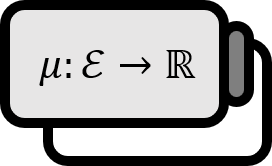Absolute Continuity of the Sign Measure
Definitions1
Given a signed measure $\nu$ and a positive measure $\mu$ on a measurable space $(X, \mathcal{E})$, for all $E \in \mathcal{E}$,
$$ \mu (E) = 0 \implies \nu (E) = 0 $$
then $\nu$ is absolutely continuous with respect to $\mu$, denoted as $\nu \ll \mu$.
Explanation
This is a generalization of absolute continuity for measures. Like measures that are absolutely continuous, the following equivalent condition holds.
$$ \nu \ll \mu \\ \iff \forall \varepsilon > 0, \exists \delta > 0 : E \in \mathcal{E}, \mu ( E ) < \delta \implies |\nu (E)| < \varepsilon $$
Proof
Since $\nu \ll \mu\ \iff |\nu| \ll \mu$ and considering that $| \nu (E)| \le |\nu| (E)$, it is sufficient to assume $\nu=$$| \nu|$ for the proof. The proof is complete because it holds for positive measures as discussed in here.
■
Similarly, as the variation $|\nu|$, $\nu^{+}$, $\nu^{-}$ of each signed measure $\nu$ being mutually singular with the positive measure $\mu$ was equivalent, so is being absolutely continuous.
Theorem 1
The following three conditions are equivalent.
- (a) $\nu \ll \mu$
- (b) $| \nu | \ll \mu$
- (c) $\nu^{+} \ll \mu \quad \text{and} \quad \nu^{-} \ll \mu$
Proof
(a) $\implies$ (b)
Let’s say that for $E\in \mathcal{E}$, $\mu (E)=0$ holds. Because $\mu$ is a positive measure, for all $F\subset E$, $F \in \mathcal{E}$, $\mu (F)=0$ holds. Then, by assumption, the following holds.
$$ \nu (F) =0,\quad \forall F\subset E $$
Hence, by the definition of a null set, $E$ is $\nu$-null. Since if $E$ is $\nu$-null then it is $|\nu |$-null, the following holds.
$$ | \nu| (E)=0 $$
Therefore, whenever $\mu (E)=0$, $| \nu |(E)=0$ holds, we obtain the following.
$$ | \nu | \ll \mu $$
(b) $\implies$ (c)
The method of proof is the same as above, so the specifics are omitted. Let’s say $\mu (E)=0$. Then, $E$ is $| \nu |$-null. Then $E$ being $\nu^{+}$null, $\nu^{-}$null implies $\nu^{+} (E)=0=\nu^{-} (E)$. Thus, whenever $\mu (E)=0$, $\nu^{+} (E)=0=\nu^{-} (E)$ holds, we obtain the following.
$$ \nu^{+} \ll \mu \quad \text{and} \quad \nu^{-} \ll \mu $$
(c) $\implies$ (a)
The method of proof is the same as above, so the specifics are omitted. Let’s say $\mu (E)=0$. Then, $E$ being $\nu^{+}$null, $\nu^{-}$null implies that it is $\nu$-null. Thus, whenever $\mu (E)=0$, $\nu (E)=0$ holds, we obtain the following.
$$ \nu \ll \mu $$
■
Theorem 2
If $\nu \perp \mu$$\nu \perp \mu$ and $\nu \ll \mu$, then $\nu=0$. In other words, $\nu$ is a constant function $0$.
Proof
Given $E \cup F=X$ and $E \cap F=\varnothing$, there exists a $\nu$-null $E$ and a $\mu$-null $F$. Since $F$ is $\mu$-null and $\nu$ is absolutely continuous with respect to $\mu$, $\mu (F)=\nu (F)=0$ holds. Now, suppose $A \in \mathcal{E}$. Then, the following holds.
$$ \nu (A) =\nu (A \cap E) + \nu (A\cap F)=0+0=0,\quad \forall A\in \mathcal{E} $$
Thus, $\nu$ is the constant function $0$.
■
See Also
- Absolute continuity of real functions
- Absolute continuity of measures
- Absolute continuity of signed measures
Gerald B. Folland, Real Analysis: Modern Techniques and Their Applications (2nd Edition, 1999), p88-89 ↩︎
